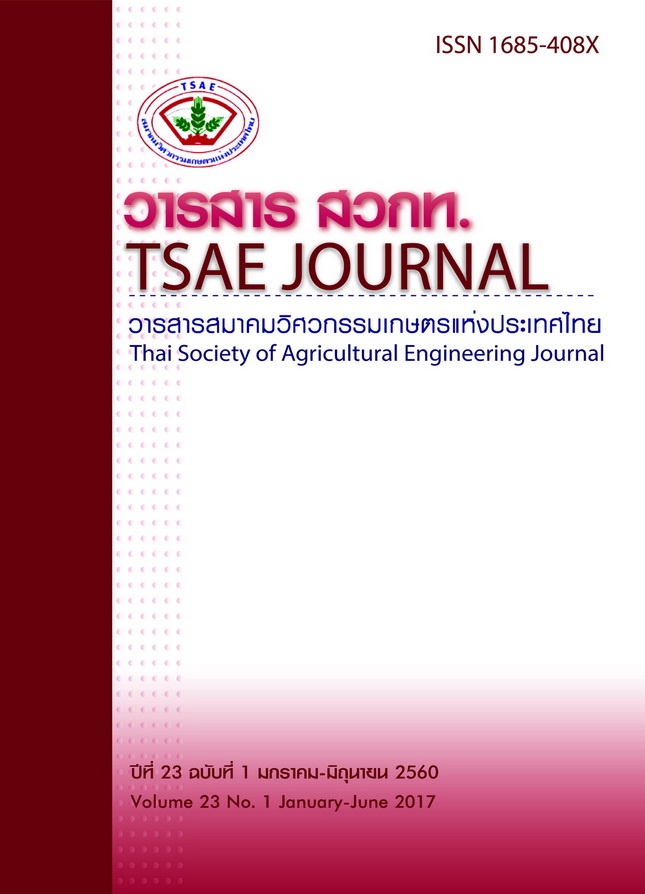การพัฒนาเครื่องวัดค่าความแน่นเนื้อในผลไม้แบบพกพาที่มีความแม่นยำ
Main Article Content
บทคัดย่อ
เครื่องต้นแบบของเครื่องมือวัดความแน่นเนื้อต้นแบบถูกออกแบบสร้างระบบสำหรับควบคุมอัตราเร็ว มุม และความลึกในการกดเพื่อวัดค่าความแน่นเนื้อ และเพื่อประเมินประสิทธิภาพ ระบบของเครื่องต้นแบบใช้สปริงแรงดึงคงที่และตัวควบคุมอัตราเร็วขนาดเล็กเพื่อควบคุมอัตราเร็วของการวัดให้คงที่ ชุดควบคุมการเคลื่อนที่เป็นเส้นตรงพร้อมด้วยเพลากลมนำมาใช้สำหรับควบคุมมุมของการวัดให้คงที่ ชุดตัวล๊อคการเคลื่อนที่ของหัวกดและฐานวางตัวอย่างใช้สำหรับควบคุมความลึกในการวัด และติดตั้งเครื่องวัดแรงแบบดิจิตัลให้สามารถเคลื่อนที่ในแนวดิ่งเพื่อวัดค่าความแน่นเนื้อ เครื่องมือที่สร้างขึ้นสามารถทำการวัดค่าความแน่นเนื้อผลไม้ได้อย่างอัตโนมัติ ที่อัตราเร็ว 210 mm min-1 โดยไม่ใช้แรงจากผู้ปฏิบัติงานในการแทงหัวกดเข้าไปยังเนื้อของผลไม้และใช้แรงจากผู้ปฏิบัติการในการนำหัวกดออกจากเนื้อผลไม้เพื่อตั้งตำแหน่งของหัวกดไปยังตำแหน่งเริ่มต้น สำหรับการประเมินประสิทธิภาพของเครื่องมือโดยใช้หัวกดแบบแบนขนาดเส้นผ่านศูนย์กลาง 8 mm เครื่องต้นแบบและเครื่องวัดความแน่นเนื้อแบบพกพา ยี่ห้อ Effegi รุ่น FT 327 ถูกนำมาทดสอบหาความสัมพันธ์ของค่าความแน่นเนื้อที่วัดได้เทียบกับเครื่อง Universal Testing Machine ซึ่งถูกกำหนดอัตราเร็วในการกด 25 mm min-1 ในมะละกอที่มีช่วงค่าความแน่นเนื้อระหว่าง 10 ถึง 100 N พบว่า เครื่องต้นแบบมีค่าความสัมพันธ์ที่มากกว่าเครื่องวัดค่าความแน่นเนื้อแบบพกพา โดยมีค่าความสัมพันธ์ (R) เท่ากับ 0.996 และ 0.971 สำหรับเครื่องต้นแบบและเครื่องวัดความแน่นเนื้อแบบพกพา ตามลำดับ ในการทดสอบความแม่นยำของเครื่องต้นแบบเทียบกับเครื่องวัดค่าความแน่นเนื้อแบบพกพาในเทอมของค่าเบี่ยงเบนมาตราฐานที่ได้จากการวัด พบว่าเครื่องต้นแบบมีค่าเบี่ยงเบนมาตราฐานน้อยกว่าเครื่องวัดความแน่นเนื้อแบบพกพาอย่างมีนัยสำคัญ ทุกช่วงค่าความแน่นเนื้อของมะละกอ
Development of Portable Precision Fruit Firmness Measurement Instrument
A prototype portable firmness measurement instrument was designed, constructed system for controlling speed rate, angle and depth of penetration and assessed performance. The system used a constant force spring, a miniature adjustable-speed control for speed rate control, a pillow-block linear bearing with shaft for angle control and pins with leveling holder for depth control, and installed a digital force gauge to allow moving in vertical direction to acquire firmness value. The instrument operated automatically to measure firmness of fruit with 210 mm min-1 speed rate of penetration without operator to drive a probe into a flesh and remove the probe out by operator to set a probe at beginning position. In performance assessment with 8 mm diameter of flat probe, the prototype instrument and a handheld penetrometer (Effegi) were used to determination correlation with a universal testing machine, which was set speed rate at 25 mm min-1 on firmness measurement in papayas with firmness range 10 to 100 N. The prototype instrument performed higher correlation than the handheld penetrometer and R was 0.996 and 0.971 for the prototype instrument and the handheld penetrometer, respectively. Another test in precision, the prototype instrument was compared to the handheld penetrometer in term of standard deviation value. The results showed lowest standard deviation value of firmness or highest precision in the prototype instrument and significantly different with the handheld penetrometer in all range of papaya firmness.
Keywords: Portable penetrometer, Fruit firmness, Precision
Article Details
สมาคมวิศวกรรมเกษตรแห่งประเทศไทย
Thai Socities of Agricultural Engineering
เอกสารอ้างอิง
บัณฑิต จริโมภาส. 2546. สมบัติทางกายภาพของผลิตภัณฑ์เกษตร. นครปฐม: ภาควิชาวิศวกรรมเกษตร, มหาวิทยาลัยเกษตรศาสตร์.
Abbott, J.A., Watada, A.E., Massie, D.R. 1976. Effe-gi, Magness-Taylor, and Instron fruit pressure testing device for apples, peaches, and nectarines. Journal of the American Society for Horticultural Science 101, 698-700.
Bron, I.U., Jacomino, A.P. 2006. Ripening and quality of ‘Golden’ papaya fruit harvested at different maturity stages. Brazilian Journal of Plant Physiology18, 389-396.
Chen, P. 1996. Quality evaluation technology for agricultural products. An invited paper for presentation at the international conference on agricultural machinery engineering. November 12-15. Seoul, Korea. 11p.
Delong, J.M., Prange, R.K., Harrison, P.A., McRae, R.B. 2000. Comparison of a new apple firmness penetrometer with three standard instruments. Postharvest Biology and Technology 19, 201-209.
Feng, J., McGlone, A., Tanner, D., White, A., Olsson, S. 2011. Effect of penetration speed on flesh firmness measured on stored kiwifruit. Postharvest Biology and Technology 61, 29-34.
Harker, F.R., Maindonald, J.H., Jackson, P.J., 1996. Penetrometer measurement of apple and kiwifruit firmness, operator and instrument differences. Journal of the American Society for Horticultural Science 121, 927–936.
Mohsenin, N. 1986. Physical Properties of Plant and Animal Materials. (2nd ed.). Gordon and Breach Science Publishers, New York.
Nicholas, R.C. 1960. Some observations on the use of fruit pressure testers. Michigan State University Agricultural Experiment Station. Quarterly Bulletin 43, 312-326.
Sancho, L.E., Yahia, E.M., Martínez-Téllez, M.A., González-Aguilar, G.A. 2010. Effect of maturity stage of papaya maradol on physiological and biochemical parameters. Agricultural and Biological Sciences 5, 194-203.
Yao, B.N., Tano, K., Konan, H.K., Bédié, G.K., Oulé, M.K., Koffi-Nevry, R., Arul, J. 2012. The role of hydrolases in the loss of firmness and of the changes in sugar content during the post-harvest maturation of Carica papaya L. var solo 8. Journal of Food Science and Technology 51(11), 3309-3316.


